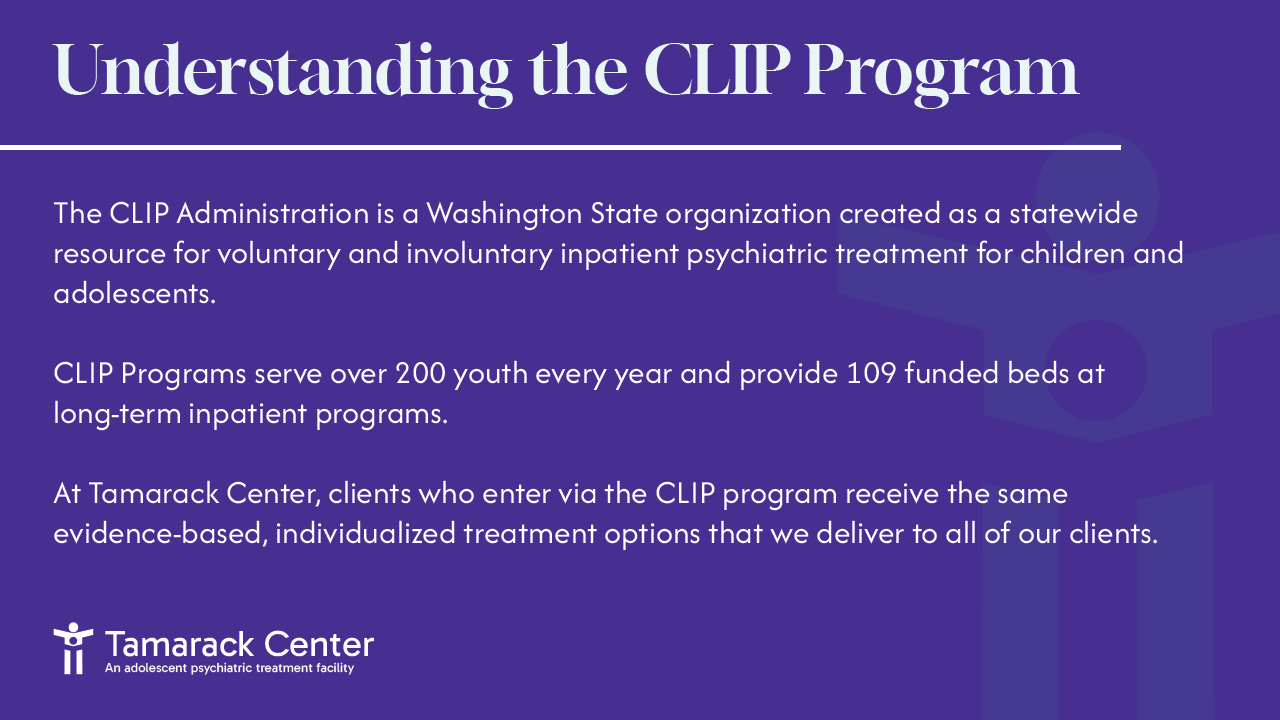The Children’s Long-Term Inpatient Program (CLIP) was created to help children and teens with severe psychiatric disorders find the behavioral health support they need to flourish. The CLIP Program at Tamarack Center provides financial support from state Medicaid dollars to help ease the barriers to mental health treatment and help your adolescent start evidence-based treatment in a comfortable community setting.
We help adolescents and teens break the cycle of self-destructive behaviors. Contact Tamarack Center to see how we can help.
Understanding the CLIP Program
The CLIP Administration is a Washington State organization created as a statewide resource for voluntary and involuntary inpatient psychiatric treatment for children and adolescents. CLIP Programs serve over 200 youth every year and provide 109 funded beds at long-term inpatient programs.
CLIP programs are not treatment in themselves, but rather a pathway to treatment for families that cannot afford to pay out-of-pocket, or whose private insurance benefits don’t cover long-term inpatient programs for their children.
CLIP covers psychiatric inpatient care in its entirety, with the vast majority of participants receiving full funding through Medicaid. For clients with private insurance, the benefits from your insurance will be applied to treatment. In rare exceptions, you may be responsible for part of the costs of treatment.
At Tamarack Center, clients who enter via the CLIP program receive the same evidence-based, individualized treatment options that we deliver to all of our clients. This service has been designed to use state funds to specifically support behavioral health for you with severe psychiatric disorders and can help your adolescent child get the caring support that they need.
Requirements for the CLIP Program

In order to be eligible for the CLIP Program, adolescents need to meet a few key criteria. These criteria are intended to keep this option open to families who need the highest degree of support and help stabilize youth diagnosed with severe psychiatric disorders that can’t be better supported with lower-intensity treatment options.
Voluntary Admission
For voluntary applicants, children need to be diagnosed with a severe psychiatric illness that requires intensive inpatient services. This could include:
- Severe depression
- Having a history of suicidal or self-injurious behavior
- Borderline personality disorder
- Severe anxiety disorders
- Sexualized behavior
- Repeated hospitalizations
- Co-occurring developmental disabilities
- Intense aggression
Additionally, voluntary applicants and their legal guardians must reside in the state of Washington. More specifically, this means that the applicant must be either in the custody of the state of Washington or in the custody of a legal guardian who is a Washington State resident.
Involuntary Admission
The other route to admission to CLIP programs is through involuntary commitment. In Washington State, adolescents may be committed to inpatient mental health treatment for up to 180 days when they have a behavioral health disorder that requires treatment, without the adolescent’s consent being required for admission, evaluation, and treatment.
This second route of admission requires that a mental health professional determines that inpatient psychiatric treatment is a medical necessity. If so, adolescents become eligible for CLIP Programs within this 180-day period.
Applying for CLIP
Voluntary referrals for CLIP are a three-step process: contacting your county’s CLIP liaison, completing a CLIP screening, and a final determination of your child’s eligibility. Each referral must go through this process to ensure that CLIP is the appropriate level of care for your child and that your family meets the requirements of the program.
Step 1: Contacting Your Local CLIP Liaison
The first step in receiving benefits from CLIP is reaching out to the CLIP liaison in your county. This is either through contacting your private or commercial health plan’s Behavioral Health Administrative Service Organizations (BH-ASO), or your Medicaid Managed Care Organization (MCO).
To find the dedicated contact in your county, visit the CLIP Administration’s website for specific and up-to-date contact information.
Contacting your liaison begins the process of verifying your child’s eligibility for the CLIP program.
Step 2: Completing the CLIP Application
Once you’ve gotten in contact with your CLIP liaison, they will help you start the process of applying for a CLIP program. This application is then submitted to a local committee for review and screening.
The local committee makes a decision on whether your family is an appropriate referral to CLIP. If they decide to make the referral, this committee will send the application off to the CLIP Administration for final review.
Step 3: Final Review
The CLIP Administration makes the final determination of CLIP eligibility. This is essentially a process of ensuring the medical necessity of intensive inpatient psychiatric treatment, which is determined by the State Certification team.
According to the CLIP Administration, 95% of applications that reach this stage are approved.
Frequently Asked Questions
Who Is a Good Candidate for CLIP?
CLIP is designed first and foremost for children and adolescents who need extensive, long-term treatment to stabilize their severe mental health condition and develop the skills needed to integrate back into their community. CLIP is not a program for children who only need housing, are better treated in outpatient settings, or have milder mental health challenges.
Is There a Waitlist for Treatment?
The CLIP program has limited beds available to help children throughout the state. If there are no beds currently available, a child is placed on a waitlist until a bed opens at the appropriate CLIP facility.
Multiple factors contribute to how long these wait times may be, including:
- Proximity to a CLIP treatment center
- Severity of clinical needs
- Age and gender
- Bed availability
- Family’s choice
CLIP is not a crisis service and may not be able to support families who need treatment immediately.
Who Pays for CLIP?
CLIP is a publicly funded program primarily paid for through Medicaid funding. The vast majority of families approved for CLIP don’t have to pay anything for their children to receive treatment.
How Many CLIP Facilities Are There?
There are four CLIP programs throughout Washington State: one in Yakima County, two in Pierce County, and Tamarack Center in Spokane.
Can I Apply for CLIP More Than Once?
There is no limit to how many times you can apply for CLIP, and adolescents can be admitted to CLIP programs multiple times if they continue to meet eligibility criteria.
Starting Treatment at Tamarack Center
CLIP is not treatment in itself – rather, it is a pathway to funding treatment with state Medicaid dollars for WA state residents. If your adolescent is determined eligible for CLIP, they receive the same effective, evidence-based treatment options provided to each client at Tamarack Center’s long-term inpatient program.
Children with severe psychiatric and behavioral disorders need extensive support to stabilize their symptoms, learn effective coping mechanisms and skills, and prepare for a healthier, more productive adulthood. At Tamarack Center, our program was created specifically to support adolescents’ long-term success, with an abundance of effective evidence-based practices designed to fit the complex treatment needs of youth.
This includes treatment components such as:
- A close-knit environment serving just 16 adolescents at a time
- Mental health treatment designed specifically for adolescents between the ages of 12-17
- A high staff-to-resident ratio
- Structured settings for adolescents to learn the skills necessary for recovery
- An on-site school to help adolescents keep up or catch up with education
- Multiple evidence-based therapy options
- An emphasis on family participation
This comprehensive approach to treating the mental health challenges of youth can provide tangible, lasting results for your family. With the support of the CLIP program and compassionate treatment from our team of trained mental health professionals, your child can get the services needed to build a happier and healthier life in recovery.
Is your child struggling with mental health? Contact Tamarack Center to find out how we can help.

